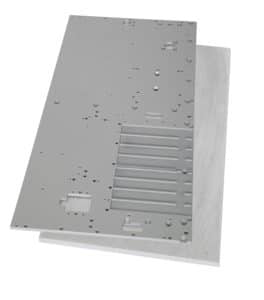Near-Net-Shape Manufacturing
Helps Reduce Buy-to-Fly Ratios-
Buy-to-Fly Ratio (BTF) is a term used mainly by additive manufacturing suppliers to substantiate the efficiencies of 3D printing. The BTF analogy is a good one, all things equal, but they are not. There are many different manufacturing methods available today, each with inherent strengths and weaknesses. One of the tenets of additive manufacturing is its ability to produce near-net-shape parts that can be finish machined with little to no material waste. The concept of near-net-shape manufacturing has been around for a long time in the form of Machine-Ready Blanks and Feature-Added Blanks.
When deploying near-net-shape manufacturing strategy, material typically arrives at your shop with one or more operations completed. This reduces the amount of material removal necessary, and in many cases allows you to get right to the high-value process of finish machining. In the aerospace industry, near-net-shape manufacturing is also used to reduce BTF ratios. The BTF ratio is the weight ratio between the raw material (buy) used for a part and the weight of the finished part (fly). In aerospace the average BTF ratio is 11:1, or for every 20,000 lbs of material, less than 2,000 lbs of parts are produced. Reducing the BTF ratio means more efficient use of material and usually reduces processing time of the finished parts.
Several manufacturing processes, including casting, forging, stamping, and most additive manufacturing techniques potentially deliver low BTF ratios. Due to surface requirements and other details, finish machining is still usually required for each of the processes, and of course, there are other considerations and trade-offs as well, such as, tooling, forming processes, and material limitations.
Machining (subtractive manufacturing) is the most common manufacturing process; it is flexible and produces strong, accurate parts. Though machining can be expensive and is thought to deliver lower BTF ratios due to the subtractive nature of the process, this is not necessarily accurate. There are substantial savings in time and processing by starting a production machining job with near-net-shape material, or Machine-Ready Blanks.
When machining flat parts from sheet or plate stock using near-net-shape material, the BTF ratio playing field quite often favors machining. Waterjet cutting allows for nesting of parts, and CAD cut added-features minimize waste. The material can be ground flat to close tolerances on all sides, and arrives at your shop clean, deburred and ready to load directly into your CNC machining center for finish machining. Remnant material removed during production of the material can be re-purposed, virtually eliminating waste and delivering a BTF ratio of nearly 1:1.
BTF ratios in general are harder to reduce when machining dimensional parts, especially those requiring a large amount of material removal. However, there are still productivity gains to be realized by starting your production job with near-net-shape material. Material prep is eliminated and the number of in-house operations can be further reduced, for example, rough cutting, hogging out material, or adding additional features.
Material specs and application will ultimately dictate your manufacturing process options, but maintaining a goal to start with near-net-shape material Machine-Ready Blanks will always save time and money, while improving production throughput.
Thanks for reading -
Ben


